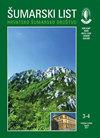Historical overview of the Deliblato sands afforestation
IF 0.4
4区 农林科学
Q4 FORESTRY
引用次数: 1
Abstract
Deliblato Sands is one of the largest sandy areas in Europe. Given that developing of vegetation on the sand is a slow process, followed by human activities that devastate the plant cover (grazing, deforestation), the free-moving sand on Deliblato Sands exited until the 18th century. Unbound sand hindered the development of agriculture in the entire southern Banat region, so it was necessary to start a more intensive process of restraining sand masses. The afforestation of this area began in 1818 and is still ongoing. In the process of afforestation, nine periods can be recognized that differ in relation to afforestation/reforestation techniques, the choice of species or the organizational structure of the forestry units (and countries) of the area of Deliblato Sands belonged throughout history.The most significant results in the binding of free moving sand were achieved by the application of black locust (Robinia pseudoacacia L.) seedlings with juniper scrub (Juniperus communis L.) laid down on open sandy areas and sowing different species of grass between the rows of seedlings. This technique has been applied since the IV afforestation period (1878-1898). The largest areas were afforested in the V period (1898-1918), when parts of Deliblato Sands were formally protected for the first time in history as areas of importance for the preservation of biodiversity. The species most used in afforestation are black locust (Robinia pseudoacacia L.), Scots pine and black pine (Pinus sylvestris L., Pinus nigra J. F. Arnold), poplars (Populus sp.), and some shrubby (e.g. Juniperus virginiana L.) and herbaceous species (e. g. Ammophilla arenaria (L.) Link, Festuca vaginata Willd., Leymus arenarius (L.) Hochst., Carex arenaria L.). Today, Robinia pseudoacacia L. is most common tree species on Deliblato Sands and it occupies almost a third of the entire area.Deliblato沙地造林的历史概况
Deliblato Sands是欧洲最大的沙质地区之一。考虑到沙子上植被的发育是一个缓慢的过程,随后是破坏植物覆盖的人类活动(放牧、砍伐森林),Deliblato Sands上自由流动的沙子一直存在到18世纪。松散的沙子阻碍了整个南部巴纳特地区的农业发展,因此有必要开始一个更密集的抑制沙团的过程。该地区的植树造林始于1818年,目前仍在进行中。在造林过程中,可以认识到德利布拉托金沙地区历史上林业单位(和国家)的造林/再造林技术、物种选择或组织结构有九个不同的时期。在自由流动沙的结合方面,最显著的结果是在开阔的沙地上施用黑蝗虫(Robinia pseudoacia L.)幼苗和杜松灌木(Juniperus commons L.),并在幼苗行之间播种不同种类的草。这项技术从第四次造林时期(1878-1898年)就开始应用。最大的区域在第五时期(1898-1918)进行了绿化,当时德利布拉托金沙的部分地区在历史上首次被正式保护,成为保护生物多样性的重要区域。造林中最常用的物种是黑蝗虫(Robinia pseudoacia L.)、苏格兰松和黑松(Pinus sylvestris L.,Pinus nigra J.F.Arnold)、白杨(Populus sp.),以及一些灌木(如Juniperus virginiana L.)和草本物种(如Ammophilla arenaria(L.)Link,Festuca vaginata Willd。,Leymus arenarius(L.)Hochst。,如今,Robinia pseudoacia L.是Deliblato Sands上最常见的树种,它几乎占据了整个面积的三分之一。
本文章由计算机程序翻译,如有差异,请以英文原文为准。
求助全文
约1分钟内获得全文
求助全文
来源期刊

Sumarski List
FORESTRY-
CiteScore
0.90
自引率
20.00%
发文量
32
审稿时长
>12 weeks
期刊介绍:
Forestry Journal publishes scientific and specialist articles from the fields of forestry, forestry-related scientific branches, nature protection and wildlife management.
 求助内容:
求助内容: 应助结果提醒方式:
应助结果提醒方式:


